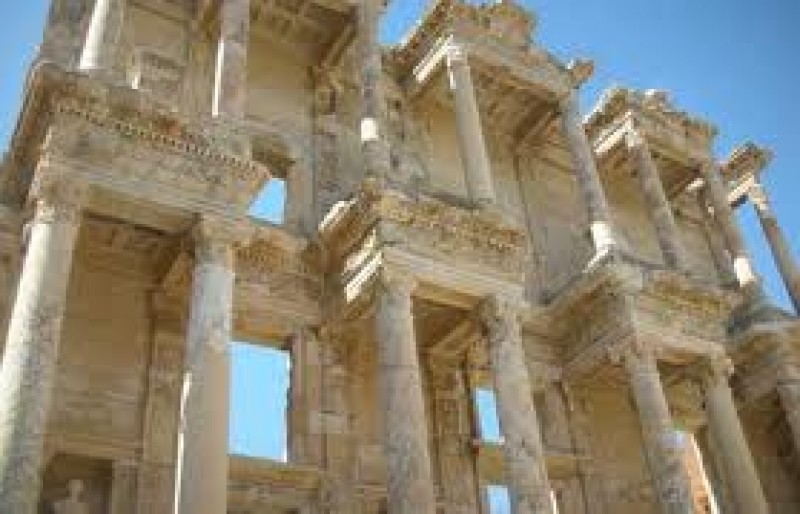TOURS
|
EPHESUS & VIRGIN MARY’S HOUSE TOUR
Advice
Product Properties :
Programme Tour starts with the visiting Ephesus which is known being the comercial, religious and the social center of Antiquity an done of the highlights of any visit in Turkey. Ephesus is probably the best combination of Grek, Roman and Byzantine civilisation. With the mithological stories and specacular ruins, you will feel like you are in ancient Ephesus. Tour programme follows the visiting Fountains of Trajan, Polio, Temples of Hadrian and Domition, Private House, Library of Celcius, Varius and Scolasticia Baths, Bouloterion and Great Theatre wtih a capacity of 24.000 spectators. A break for the lunch before next stop, House of Virgin Mary, where she spent last days of her life. Final destination is Archaeological Museum of Ephesus.
Including : English speaking professional tour guide, transportation by A/C vehicle, all entry fees to the sites & museums, service charges & local taxes, lunch.
Excluding : All personal expenses, tips to the tour guide and driver, everything which is not particulaly mentioned in “including” section.
EPHESUS ANTIENT CITY Classical periodEphesus continued to prosper. But when taxes continued to be raised under Cambyses II and Darius, the Ephesians participated in the Ionian Revolt against Persian rule in the Battle of Ephesus (498 BC), an event which instigated the Greco-Persian wars. In 479 BC, the Ionians, together with Athens and Sparta, were able to oust the Persians from the shores of Asia Minor. In 478 BC, the Ionian cities entered with Athens and Sparta into the Delian League against the Persians. Ephesus did not contribute ships but gave financial support by offering the treasure of Apollo to the goddess Athena, protectress of Athens. During the Peloponnesian War, Ephesus was first allied to Athens but sided in a later phase, called the Decelean War, or the Ionian War, with Sparta, which also had received the support of the Persians. As a result, rule over the cities of Ionia was ceded again to Persia. These wars did not much affect daily life in Ephesus. The Ephesians were surprisingly modern in their social relations. They allowed strangers to integrate. Education was much valued. Through the cult of Artemis, the city also became a bastion of women's rights. Ephesus even had female artists. In later times, Pliny the Elder mentioned having seen at Ephesus a representation of the goddess Diana by Timarata, the daughter of a painter. In 356 BC the temple of Artemis was burned down, according to legend, by a lunatic called Herostratus. The inhabitants of Ephesus at once set about restoring the temple and even planned a larger and grander one than the original. Hellenistic periodWhen Alexander the Great defeated the Persian forces at the Battle of Granicus in 334 BC, the Greek cities of Asia Minor were liberated. The pro-Persian tyrant Syrpax and his family were stoned to death, and Alexander was greeted warmly when he entered Ephesus in triumph. When Alexander saw that the temple of Artemis was not yet finished, he proposed to finance it and have his name inscribed on the front. But the inhabitants of Ephesus demurred, claiming that it was not fitting for one god to build a temple to another. After Alexander's death in 323 BC, Ephesus in 290 BC came under the rule of one of Alexander's generals, Lysimachus. As the river Cayster (Grk. name Κ??στρος) silted up the harbor, the resulting marshes caused malaria and many deaths among the inhabitants. The people of Ephesus were forced to move to a new settlement two kilometers further on, when the king flooded the old city by blocking the sewers.This settlement was officially called Arsinoea (Ancient Greek: ?ρσιν?εια or ?ρσινο?α) after the king's second wife, Arsinoe II of Egypt. After Lysimachus had destroyed the nearby cities of Lebedos and Colophon in 292 BC, he relocated their inhabitants to the new city. Ephesus revolted after the treacherous death of Agathocles, giving the Hellenistic king of Syria and Mesopotamia Seleucus I Nicator an opportunity for removing and killing Lysimachus, his last rival, at the Battle of Corupedium in 281 BC. After the death of Lysimachus the town again was named Ephesus. Thus Ephesus became part of the Seleucid Empire. After the murder of king Antiochus II Theos and his Egyptian wife, pharaoh Ptolemy III invaded the Seleucid Empire and the Egyptian fleet swept the coast of Asia Minor. Ephesus came under Egyptian rule between 263–197 BC. When the Seleucid king Antiochus III the Great tried to regain the Greek cities of Asia Minor, he came in conflict with Rome. After a series of battles, he was defeated by Scipio Asiaticus at the Battle of Magnesia in 190 BC. As a result, Ephesus came under the rule of the Attalid king of Pergamon Eumenes II (197–133 BC). When his grandson Attalus III died without male children of his own, he left his kingdom to the Roman Republic.
Roman periodEphesus, a territory that was traditionally Greek to the core, became subject of the Roman Republic. The city felt at once the Roman influence. Taxes rose considerably, and the treasures of the city were systematically plundered. In 88 BC Ephesus welcomed Archelaus, a general of Mithridates the Great, king of Pontus, when he conquered Asia (the Roman name for western Asia Minor). This led to the Asiatic Vespers, the slaughter of 80,000 Roman citizens in Asia, or any person who spoke with a Latin accent. Many had lived in Ephesus. But when they saw how badly the people of Chios had been treated by Zenobius, a general of Mithridates, they refused entry to his army. Zenobius was invited into the city to visit Philopoemen (the father of Monime, the favorite wife of Mithridates) and the overseer of Ephesus. As the people expected nothing good of him, they threw him into prison and murdered him. Mithridates took revenge and inflicted terrible punishments. However, the Greek cities were given freedom and several substantial rights. Ephesus became, for a short time, self-governing. When Mithridates was defeated in the First Mithridatic War by the Roman consul Lucius Cornelius Sulla, Ephesus came back under the Roman rule in 86 BC. Sulla imposed a huge indemnity, along with five years of back taxes, which left Asian cities heavily in debt for a long time to come. When Augustus became emperor in 27 BC, he made Ephesus instead of Pergamum the capital of proconsular Asia, which covered western Asia Minor. Ephesus entered an era of prosperity. It became the seat of the governor, growing into a metropolis and a major center of commerce. It was second in importance and size only to Rome.Ephesus has been estimated to be in the range of 400,000 to 500,000 inhabitants in the year 100, making it the largest city in Roman Asia and of the day. Ephesus was at its peak during the 1st and 2nd century AD. The city was famed for the Temple of Artemis (Diana), who had her chief shrine there, the Library of Celsus, and its theatre, which was capable of holding 25,000 spectators. This open-air theater was used initially for drama, but during later Roman times gladiatorial combats were also held on its stage, with the first archaeological evidence of a gladiator graveyard found in May 2007.The population of Ephesus also had several major bath complexes, built at various points while the city was under Roman rule. The city had one of the most advanced aqueduct systems in the ancient world, with multiple aqueducts of various sizes to supply different areas of the city, including 4 major aqueducts. They fed a multiple set of water mills, one of which has been identified as a sawmill for marble. The city and temple were destroyed by the Goths in 263 AD. This marked the decline of the city's splendor. Byzantine era (395–1071)Ephesus remained the most important city of the Byzantine Empire in Asia after Constantinople in the 5th and 6th centuries. The emperor Constantine I rebuilt much of the city and erected a new public bath. In 406 John Chrysostom, archbishop of Constantinople, ordered the destruction of the Temple of Artemis.Emperor Flavius Arcadius raised the level of the street between the theatre and the harbour. The basilica of St. John was built during the reign of emperor Justinian I in the 6th century. The town was again partially destroyed by an earthquake in 614.
The importance of the city as a commercial center declined as the harbor was slowly silted up by the river (today, K |
|||
Product Details
|
|||
|
Duration : Approx. 7 hours
Location : Pick-up from Izmir and Kusadasi |
|||

© Copyright 2025 - Pacolini Tours | Hotel Accomodation | izmir, istanbul, ephesus, kusadasi, cappodoccia, virgin mary house, tour, tours
![]() © 2012 All Rights Reserved Pacolini. Use of this website constitutes acceptance of Pacolini's Terms & Conditions.
© 2012 All Rights Reserved Pacolini. Use of this website constitutes acceptance of Pacolini's Terms & Conditions.
Address: Gaziosmanpaşa Blv.No:2/E ALSANCAK/İZMİR
Phone :+90 232.446 01 44
Fax: +90 232.446 01 44
Mobile: +90.532.597 58 14
E mail: faruk@pacolini.com






















